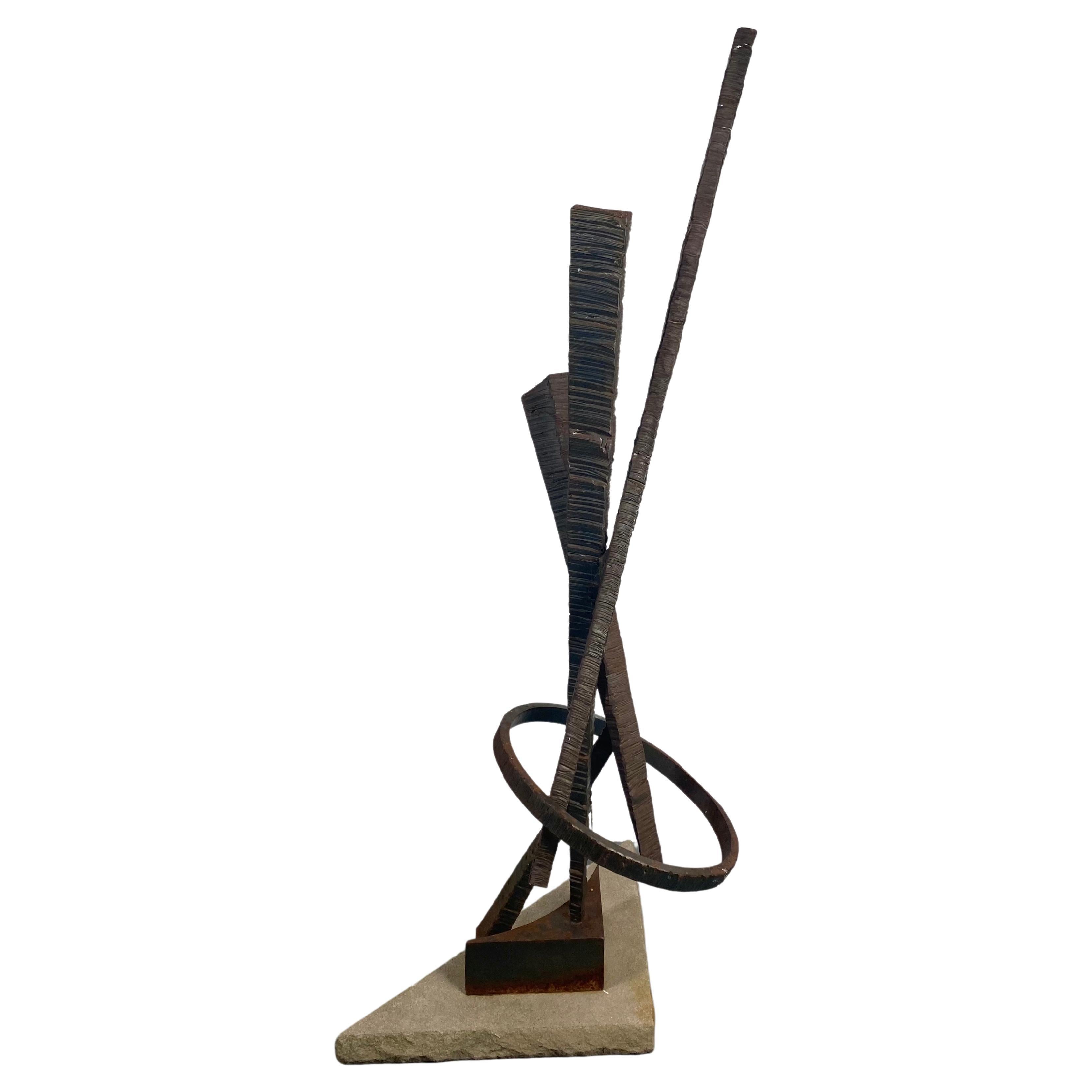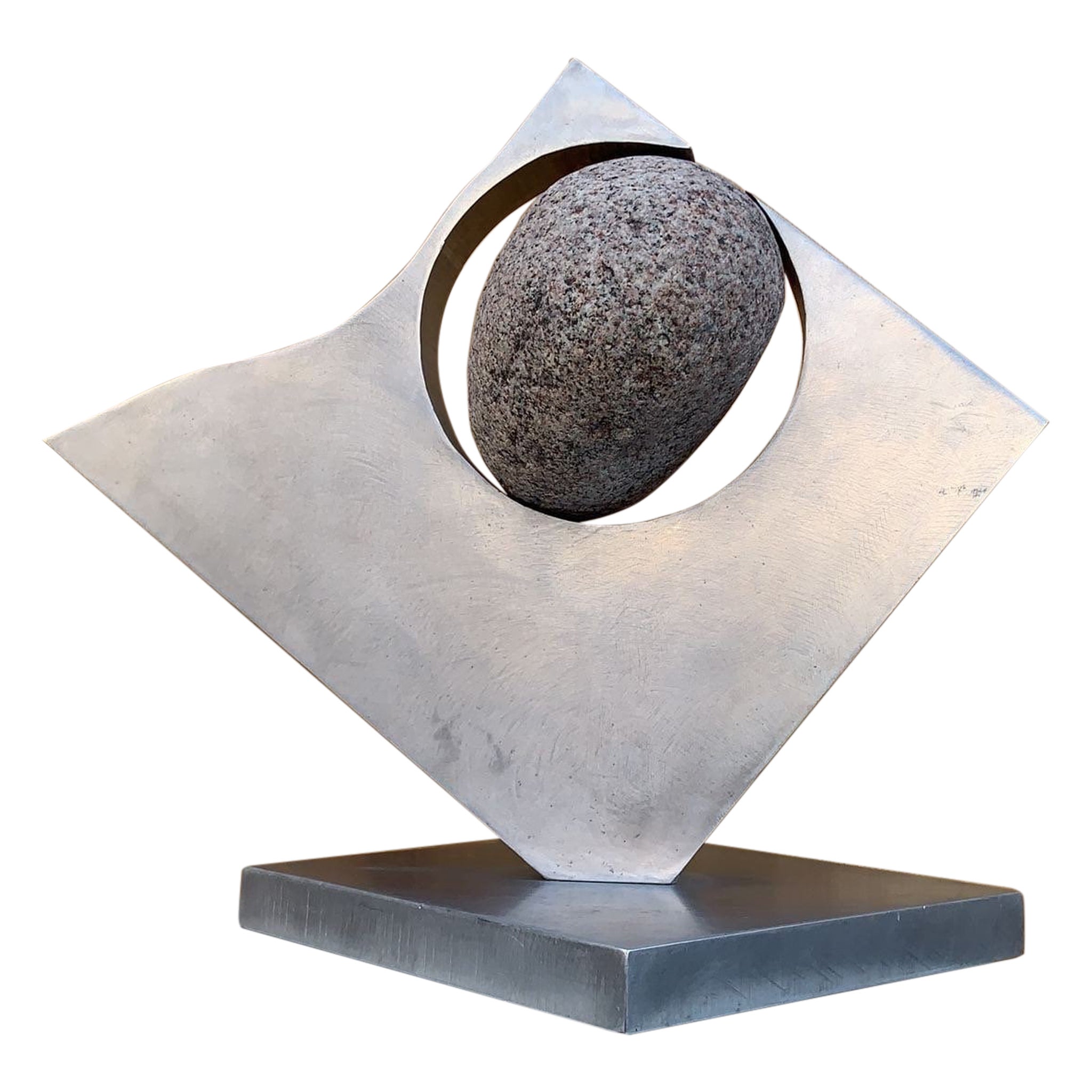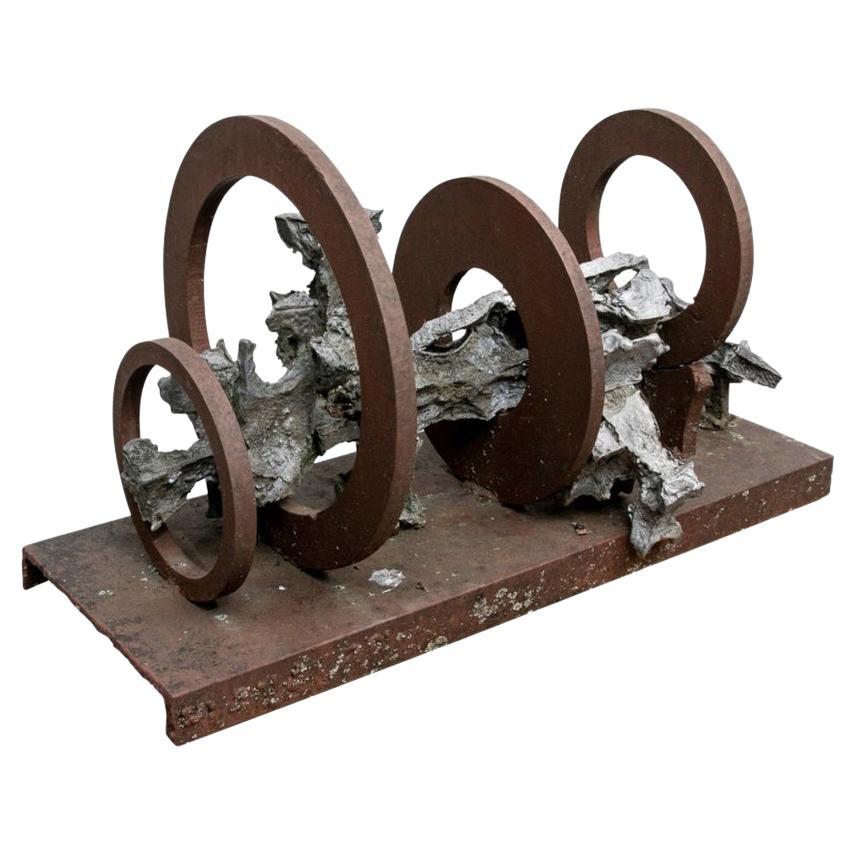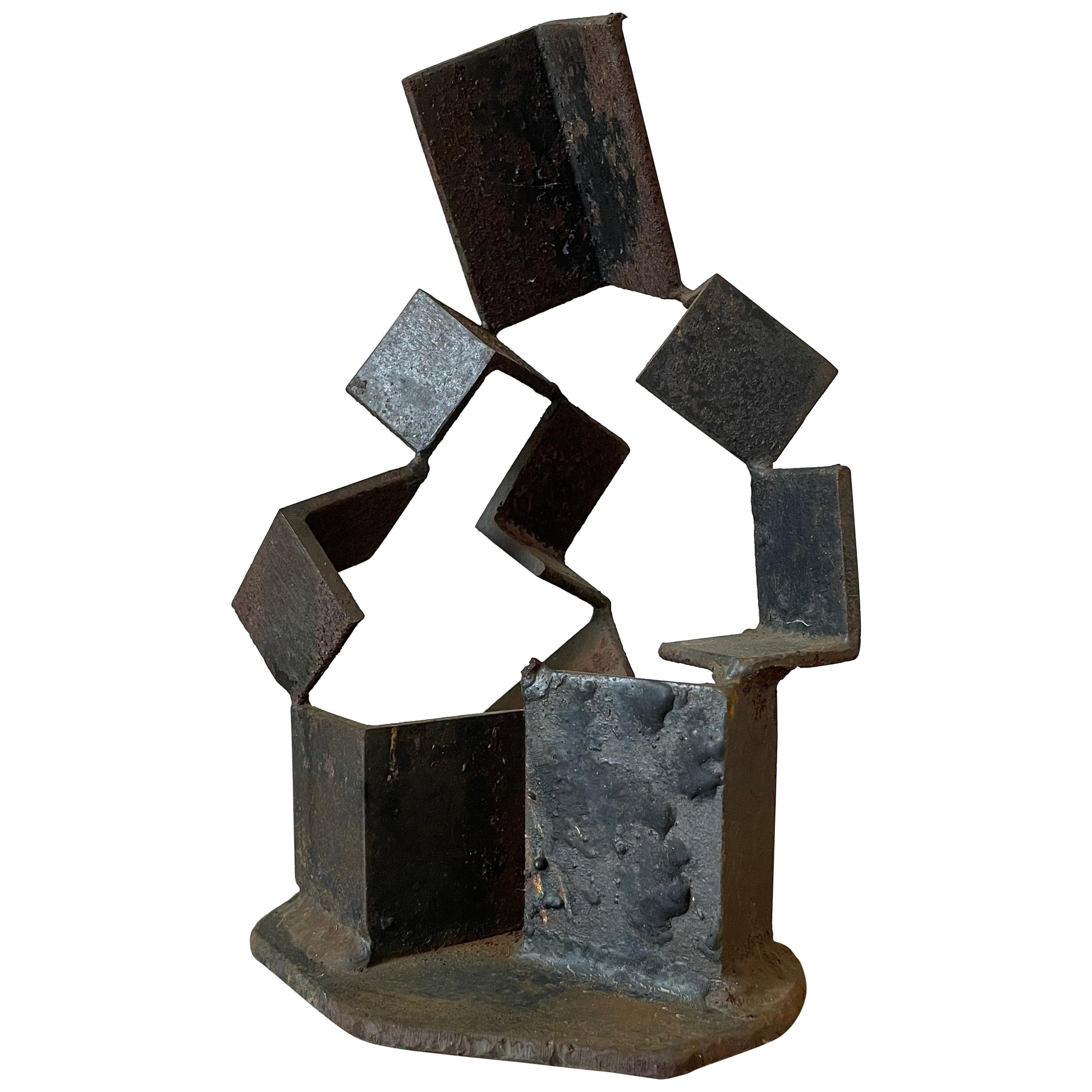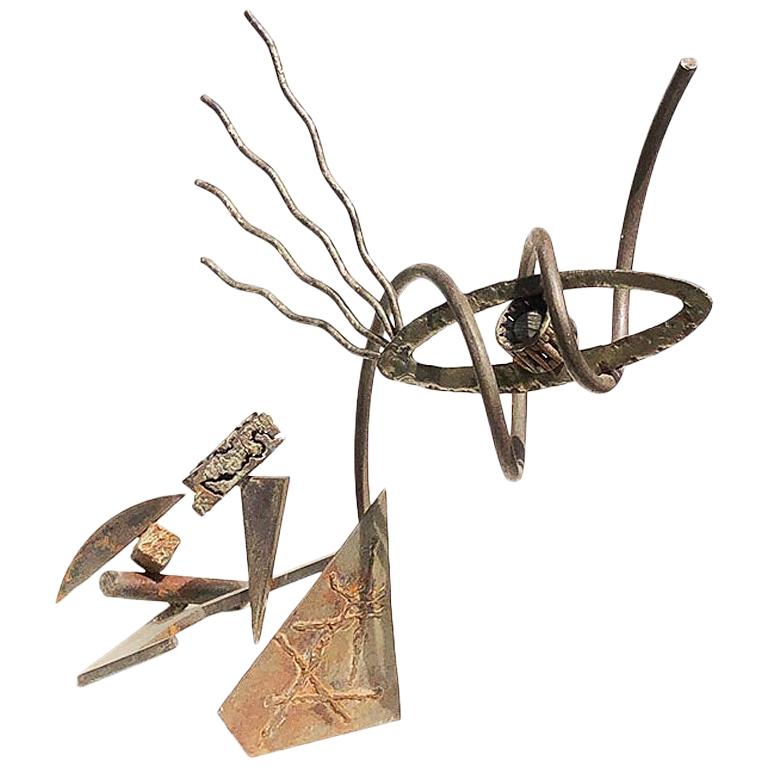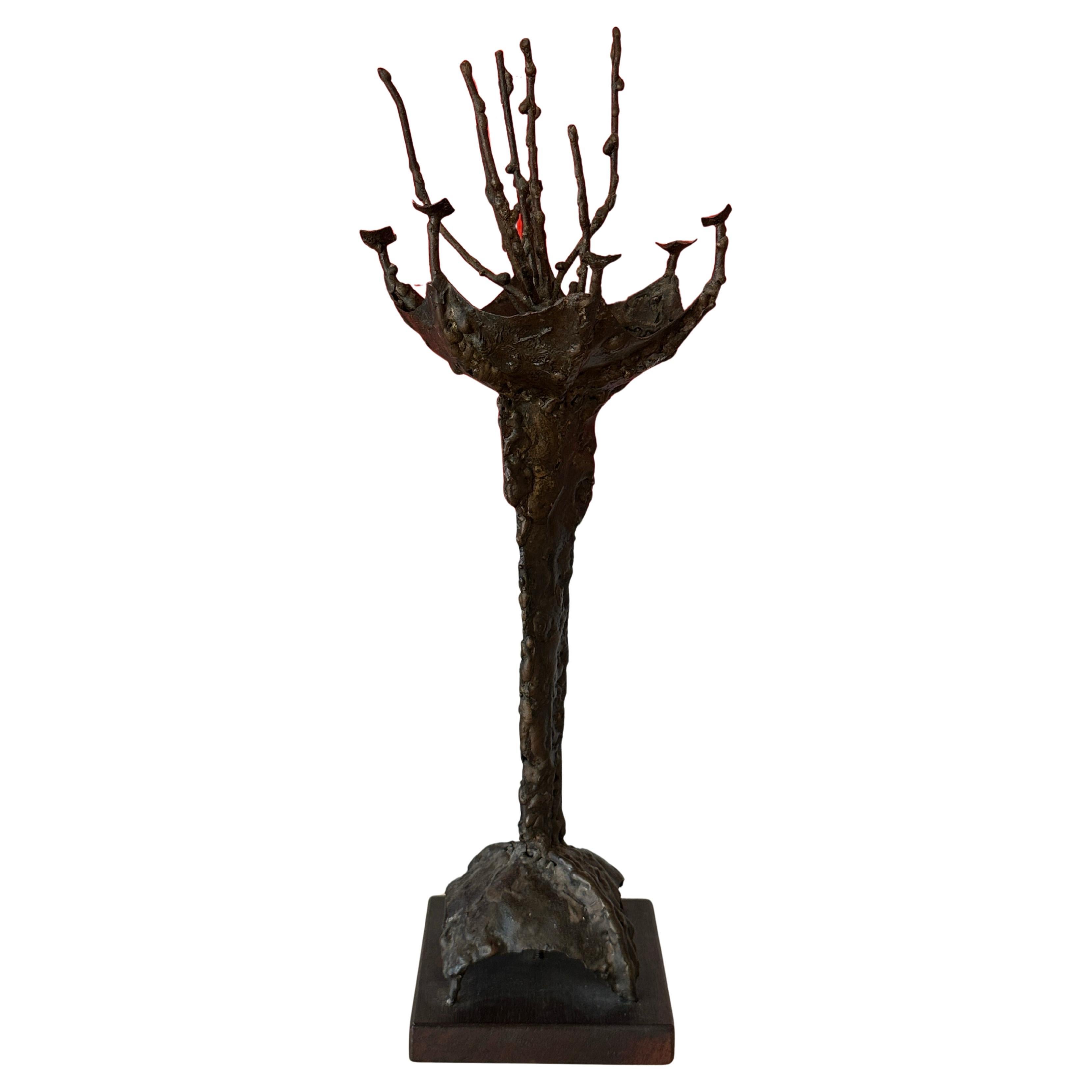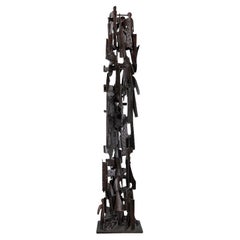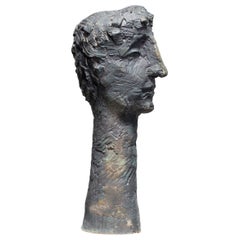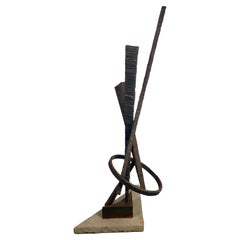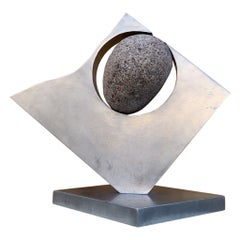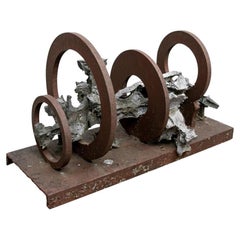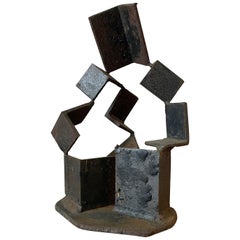Items Similar to Robert Bielat Sculpture Cast Bi-Metal Stone Wood "TRUE EAST"
Want more images or videos?
Request additional images or videos from the seller
1 of 11
Robert Bielat Sculpture Cast Bi-Metal Stone Wood "TRUE EAST"
$1,450
£1,101.39
€1,269.18
CA$2,041.96
A$2,263.81
CHF 1,189.72
MX$27,705.37
NOK 14,858.42
SEK 13,946.12
DKK 9,473.63
About the Item
SALE ONE WEEK ONLY
"Robert Bielat was an artist’s artist, a sobriquet applied to those whose work is brilliant but idiosyncratic, deeply compelling in a way that is obvious to those who can see it, but not necessarily so to the market or to the arbiters of so-called “good” taste.
A Bielat exhibition typically overflowed with work, a reflection of his seemingly boundless creativity and, in no small measure, an acknowledgment of his perceived need to get as many of his ideas out into the world as possible in the brief time he had to be a sentient part of it. (Bielat’s work truly embodies the adage: “Ars longa; vita brevis.”) Be that as it may, there are certain themes running through his oeuvre worth remarking upon.
The most obvious and central is the Romantic notion of the will-to-art, a self-determined, intuitive, and autopoetic approach to creative production whereby Bielat absorbed his experience of the world around him and reprocessed it into an expressive vision that was uniquely his own. Bielat possessed an advanced degree in art, but his work seemed to be completely sui generis, as if appearing out of nowhere fully formed, a result of its own conditions of being, and as if it had always been there.
This brings up the notion of time in Bielat’s work, specifically, the phenomenological concept of “sedimentation”—that the past is embedded in the present and that the present is ground from which the future emerges—which is both physically and metaphorically manifest in the work. This is evident in Bielat’s use of the castoff in many works over the years.
Bielat’s re-adoption of bronze manifests another important element in his work, namely, its materiality. Bielat always asserted the primacy of the thing in his production, whether it be the collection of objects, old and new, that he integrated into sculptures or the metals he used in casting. His approach to ceramics, as well, reflected an engagement with the material limits of the medium—severely distressing the clay, slathering on the glaze, leaving sections of bisqueware visible.
The multifaceted ways in which Bielat worked his materials suggests one last aspect of his aesthetic: his concern for craft. Bielat completed his undergraduate studies at what is now College for Creative Studies when it was the School of the Detroit Society of Arts and Crafts, whose “maker” aesthetic has maintained its influence throughout his work. There was always a certain way that Bielat approached his work, not just in his concern for materials, but in how he insisted on maintaining the visibility of the steps taken in its making. Bielat always worked directly, eschewing preparatory sketches or studies. He maintained an iterative dialog with his work, responding as much to its internal dictates—making adjustments along the way—as exercising control over its development.
The philosopher Maurice Merleau-Ponty once wrote the following, which resonates in considering Bielat:
“What one too deliberately seeks, one does not find; and he who on the contrary has in his meditative life known how to tap its spontaneous source never lacks for ideas and value.”
Robert Bielat lived that principle, as an artist and as a human being. The work is his testament."
-Vince Carducci, June 2019
Robert Bilat explains his method via the following:
Bi-metal casting is a process I have been refining throughout my career. The technique of bi-metal casting is the casting of a metal with a low melting point, such as aluminum, around or into a static metal, such as steel, which melts at a higher temperature. Bi-metal casting can be done with bronze or aluminum, combined with a static metal with a higher melting point.
My sculpture constructions are first created with steel and stone affixed into Styrofoam. After the sculpture is completed, it is packed tightly in a foundry box with a 10 percent bentonite and 90 percent sand mixture. The bottom is filled by “ramming”, which is the technique of pounding the bentonite/sand mixture very tightly. The sculpture is placed in the box, and sand is carefully rammed around the sculpture, layered in inches at a time like a parfait. This continues until the sand is level with the top of the box.
After the foundry box is ready, the molten metal is precisely poured from the crucible into the gates, which lead to the Styrofoam portion of the sculpture. The Styrofoam turns into gas and dissipates up through the sand and clay mixture when it is hit by the molten metal. The heat from the molten metal fuses the particles of bentonite with the sand, creating a mold around the sculpture. This is Bi-Metal Casting.
- Dimensions:Height: 12 in (30.48 cm)Width: 6.5 in (16.51 cm)Depth: 12 in (30.48 cm)
- Style:Expressionist (In the Style Of)
- Materials and Techniques:
- Place of Origin:
- Period:
- Date of Manufacture:2000s
- Condition:
- Seller Location:Bloomfield Hills, MI
- Reference Number:1stDibs: LU7781235361252
About the Seller
5.0
Vetted Professional Seller
Every seller passes strict standards for authenticity and reliability
1stDibs seller since 2022
20 sales on 1stDibs
Typical response time: 20 hours
- ShippingRetrieving quote...Shipping from: Detroit, MI
- Return Policy
Authenticity Guarantee
In the unlikely event there’s an issue with an item’s authenticity, contact us within 1 year for a full refund. DetailsMoney-Back Guarantee
If your item is not as described, is damaged in transit, or does not arrive, contact us within 7 days for a full refund. Details24-Hour Cancellation
You have a 24-hour grace period in which to reconsider your purchase, with no questions asked.Vetted Professional Sellers
Our world-class sellers must adhere to strict standards for service and quality, maintaining the integrity of our listings.Price-Match Guarantee
If you find that a seller listed the same item for a lower price elsewhere, we’ll match it.Trusted Global Delivery
Our best-in-class carrier network provides specialized shipping options worldwide, including custom delivery.More From This Seller
View AllTony Rosenthal Abstract Sculpture Blackened Steel Red Blushes
By Tony Rosenthal
Located in Bloomfield Hills, MI
SALE ONE WEEK ONLY
UNTITLED is an abstract blackened steel sculpture that has a continuous lively movement. The positioning of the heavy metal is suggestive of dance. There are similarities to the sculptors, Robert Sestok and Tony Smith, who both worked in bronze and painted steel with similar cut out pieces and abstract designs. Untitled has a joyous aura and its small size makes it a charming intimate piece. It might have been a maquette for a much larger piece. The design works in this 14" height as it would in a 14' height. There is a Letter of Certification that will accompany the sculpture.
Tony Rosenthal (1914 - 2009) is best known for creating a staggering list of monumental public art sculptures. For over seven decades Tony Rosenthal created an arc of sculpture in a variety of sizes, styles and media, including wood, steel, bronze, brass, cement and aluminum. Every day millions see, enjoy and interact with art created by Rosenthal in cities around the world. In New York City alone, five Rosenthal public art sculptures have been beloved and visible 24/7 for over four decades, yet Rosenthal is not a household name. Art dealer Joseph K. Levene, told The New York Times, Tony Rosenthal "reminds me of a character actor. You know the face but not the name. With him, you know the art."
Tony Rosenthal dedicated his life to creating art and actively created sculpture everyday in his Southampton, New York studio until he passed away at the age of 94, July 28, 2009. At nine Rosenthal learned the fundamentals of carving sculpture when his mother, an opera singer enrolled him in children's classes at the Art Institute of Chicago where he learned how to carve sculptures in soap. In 1936 Rosenthal earned a B.F.A. from the University of Michigan, and in 1952 became the first instructor of sculpture at the University of California, Los Angeles. In 1950 Rosenthal was recipient of the San Francisco Museum of Modern Art’s sculpture award; in 1967, Rosenthal received the outstanding achievement award from the University of Michigan and in 1963 a Ford Foundation Grant.
After graduating from the University of Michigan, Rosenthal became studio assistant to Alexander Archipenko, the figurative master sculptor, casting bronzes in exchange for sculpture lessons; at night, Rosenthal taught evening classes in drawing and sculpture. In 1939, Rosenthal enrolled at Cranbrook Academy of Art, studying with Carl Milles, Cranbrook's sculptor in residence; there, Rosenthal forged friendships with husband and wife designers Charles Eames and Ray Eames and the sculptor Lilian Swann Saarinen the wife of architect, Eero Saarinen.
Decades later Rosenthal acknowledged his gratitude to Cranbrook by donating his archives to them. The Cranbrook Cube, 1984, a 90" painted aluminum cube is in the Cranbrook Museum collection. In 1942, Rosenthal was drafted into the U.S. Army; while stationed in Paris Rosenthal forged friendships with George Braque, Andre Derain, Le Corbusier and Constantin Brancusi, routinely organizing and accompanying groups of soldiers on studio visits. Through multiple visits to Brancusi's Paris studio, Rosenthal learned to create and forge metal sculpture...
Category
Late 20th Century American Modern Abstract Sculptures
Materials
Steel
Robert Sestok "Cass Corridor Artist" Detroit Abstract Welded Steel
By Robert Sestok
Located in Bloomfield Hills, MI
The "Untitled" abstract sculpture by Robert Sestok has a very deliberate aura of strength in its columnar shape. Upon closer inspection details emerge su...
Category
Vintage 1980s American Expressionist Abstract Sculptures
Materials
Steel
Judy Brady Sculpted Ceramic Head
Located in Bloomfield Hills, MI
The UNTITLED portrait sculpture has a quiet yet powerful and commanding aura. The viewer cannot be around or near it without feeling its presence. It has a very classical approach in...
Category
Vintage 1970s American Expressionist Busts
Materials
Ceramic, Paint
Ruben Nakian Bronze Figurine "Leda and the Swan" Limited Edition
By Reuben Nakian
Located in Bloomfield Hills, MI
SALE ONE WEEK ONLY
“Leda and the Swan” is by Reuben Nakian (1897 - 1986). He was an American sculptor and teacher of Armenian extraction. His works’ recurring themes are from Greek and Roman mythology. Nakian’s small bronzes achieve majesty and power which are not dependent on size and amplitude. With characteristic freshness, he has reinterpreted the classical subject of Leda and the Swan refining it in the Classical-Renaissance-Baroque tradition in a contemporary way. Dr. Robert P. Metzger gives us his aesthetic interpretation of this work which retells the myth in classical hedonism and freedom of expression showing Leda and the Swann prior to her being ravaged and during their first meeting. “The young virgin is fascinated with her new found friend and accepts him in a spirit of playfulness, contentment and wonder. She is dreamily available and shyly seductive as the deceptively tame swan snuggles up to her with its phallic-like neck.” Leda appears composed, placid yet open and available as compared to her more intense and passionate states in other of Nakian’s depictions on the same theme. This was cast at the "Renaissance Art Foundry" in 1978 and is so marked on the base being #5 of 7.
It is believed that “no other sculptor of the twentieth century matched Rueben’s heroic renditions with the grand themes of Western Art. His erotic mythological figures exude a joyous energy of gesture and movement which place them among seminal sculptural achievements of the past one hundred years.”
Nakian studied at the Independent School of Art in New York City previously known as the Robert Henri School … with Homer Boss...
Category
Vintage 1970s American Figurative Sculptures
Materials
Bronze
Edgardo Simone Nude Figurative Sculpture "THE KISS"
By Edgardo Simone
Located in Bloomfield Hills, MI
SALE ONE WEEK ONLY
Edgardo Simone (Italian/American, 1890-1948) The Kiss patinated plaster casting sculpture for kissing nudes fountain sculpture signed to top of base.
Classically trained in Italy at the Beaux Arts Academy in Rome from 1906 to 1913, Edgardo Simone became a famous sculptor in Italy and the United States using mediums of terracotta, ceramic, bronze, and plaster. He earned a Doctorate of Design and Sculpture at the Academy and then emigrated to the United States where he worked in New York, Chicago and southern California.
His style was influenced by Art Nouveau, Art Deco and other modernist influences. In Italy he had received three times the Croix de Guerre and was decorated by King Victor Emmanuel II and Queen Margherita. Before moving to America, he had much recognition in Italy. He had created war, funeral and city monuments in twenty-six Italian cities. When he arrived in New York City, one of the newspapers carried a headline: "Italy's greatest Sculptor Arrives in New York."
In New York, Simone became prominent in society and did many portrait busts including of Thomas Edison, John J. Pershing, Henry Ford and Louis Brandeis...
Category
Early 20th Century North American Art Nouveau Figurative Sculptures
Materials
Plaster
John Glick Plum Tree Pottery "Wall Mantel Series"
By John Glick
Located in Bloomfield Hills, MI
John Glick is well-known for his beautifully rendered functional pieces of art. His decorative pieces, especially his large pots, are breathtakingly powerful objects. Glick's creative genius, however, is most exquisitely shown in this unique grouping of objets d'art. The Wall Hanging has a lovely classical scroll shelf. The objets on the shelf include an apple and pear - both fruits frequently rendered by artists from the Dutch Masters to Cezanne because of their perfectly balanced shape and rich colors. In addition is a small Greek or Roman styled dish used as an oil lamp. The other three objets are mysterious twisted tube-like organic shapes. John Glick, at one of his richest, creative bests. The objets are of various sizes, movable and can be displayed as desired. The size given is the overall size of both pieces and the objets d'art.
John was an American Abstract Expressionist ceramicist born in Detroit, MI. Though open to artistic experimentation, Glick was most influenced by the styles and aesthetics of Asian pottery—an inspiration that shows in his use of decorative patterns and glaze choices. He has said that he is attracted to simplicity, as well as complexity: my work continually reflects my re-examination that these two poles can coexist… or not, in a given series. Glick also took influences from master potters of Japan, notably Shoji Hamada and Kanjrio Kawai, blending their gestural embellishments of simple forms with attitudes of Abstract Expressionism. He was particularly drown to the work of Helen Frankenthaler whose soak-stain style resonated with Glick’s multi-layered glaze surfaces, which juxtaposed veils of atmospheric color with gestural marks and pattern. He spent countless hours developing and making his own tools in order to achieve previously unseen results in his work with clay and glaze.
Glick’s “Plum Tree Pottery” (now a designated historic landmark in Farmington Hills, Michigan) studio opened around 1965 and closed in the summer of 2016. It was a private studio space for John and a number of his students and assistants. He believed his shapes evolved guided by forces apparently outside his control. This was instinctual, intellectual and due to his openness to change, fusing into what he thought was the most positive force behind a potter’s approach: evolution and growth. Some have called it inspiration.
John was not only a major figure in the Detroit creative community, but in the ceramics world at large. According to Shelley Selim in her book on John, “John Glick: A Legacy in Clay” John remains: “one of the most recognizable names in the field of studio pottery – known for lecturing, publishing, and offering workshops widely – and his work has been featured in well over a hundred local, national and international exhibitions since he was a college student in the late 1950s.” Along with this John has mentored over thirty studio apprentices over five and a half decades, received numerous grants and awards for his work, and has been prolific, with an estimated 300,000 ceramic wares throughout the world.
He received his Masters from Cranbrook Academy of Art in Bloomfield Hills, Michigan, working with Maija Grotell, a legendary and influential teacher. Grotell was noted for her deep interest in the human connection to nature’s rhythms and patters. These ideas often grounded her dialog with her students including Glick, affecting, a profund and lasting influence on his future work. This famous Art Academy was designed by architect and faculty member, Eliel Saarinen who collaborated with Charles and Ray Eames on chair and furniture design. Numerous creative artists who are alumni of Cranbrook include: Harry Bertoia, Florence Knoll, Jack Lenor Larsen, Donald Lipski, Duane Hanson, Nick Cave, Hani Rashid, George Nelson, Urban Jupena (Nationally recognized fiber artist), Artis Lane (the first African-American artist to have her sculpture, "Sojourner Truth," commissioned for the Emancipation Hall in the Capital Visitor Center in Washington DC), Cory Puhlman (televised Pastry Chef extraordinaire), Thom O’Connor (Lithographs), Paul Evans (Brutalist-inspired sculpted metal furnishings), Eugene Caples (small bronze images/abstract), Morris Brose (Bronze Sculptures), Herb Babcock (blown glass), Larry Butcher (mixed media) and Lauren Anais Hussey...
Category
Late 20th Century American American Craftsman Mounted Objects
Materials
Ceramic
You May Also Like
Brutalist Welded Steel & Stone Abstract Sculpture by Sue Taves, Indoor/Outdoor
By Sue Taves
Located in Buffalo, NY
Stunning brutalist welded steel & stone abstract sculpture by Sue Taves . great indoor or outdoor,,garden.. Powerful composition,, signed and dated,, Modernist abstract,,
Category
1990s American Brutalist Sculptures and Carvings
Materials
Stone, Cut Steel
Vintage Thomas C. Hicks Jr. Steel and Stone Sculpture
Located in Chicago, IL
Vintage Thomas C. Hicks Jr. Steel and Stone Sculpture
About The Artwork
Born in Amarillo, TX in 1927, Tommy graduated from West Texas State University in 1952. When he was 45 year...
Category
Mid-20th Century American Minimalist Abstract Sculptures
Materials
Stone, Steel
Mid Century Brutalist Iron And Slag Abstract Sculpture
Located in Bridgeport, CT
An Elemental welded Iron and Slag Metal Sculpture in Brutalist Style. Signed along the base. A series of four Iron Rings with Rust patina with gray slag metal in between. Mounted on an base. Sculpted by Multidisciplinary Artist Norma Flanagan who during her lifetime worked in Stone, Metal, Ceramics, Painting and Drawing.
L. 25", Depth 10 1/2", H. 16 1/2", Diam. largest ring 13...
Category
Vintage 1970s American Brutalist Abstract Sculptures
Materials
Iron
Patinated Steel Modernist Sculpture
Located in St.Petersburg, FL
Unusual welded steel sculpture which consists of multiple pieces attached at the corners producing a floating appearance.
Category
Vintage 1970s American Mid-Century Modern Abstract Sculptures
Materials
Steel
Large Modern Brutalist Bronze Iron Sculpture 21st Century Signed
Located in Oklahoma City, OK
Large bronze iron Brutalist style modern sculpture by Oklahoma City artist Basil Martin, circa 2001. Beautifully crafted and can be displayed at any angle. We love the angle as shown...
Category
Early 2000s American Brutalist Abstract Sculptures
Materials
Bronze, Iron
$3,600 Sale Price
20% Off
Brutalist Bronze Sculpture by Ralph Tazian
By Paul Evans
Located in North Hollywood, CA
Brutalist bronze sculpture on a mahogany base by Laguna Beach based artist Ralph Tazian
Category
Vintage 1970s American Brutalist Abstract Sculptures
Materials
Bronze
